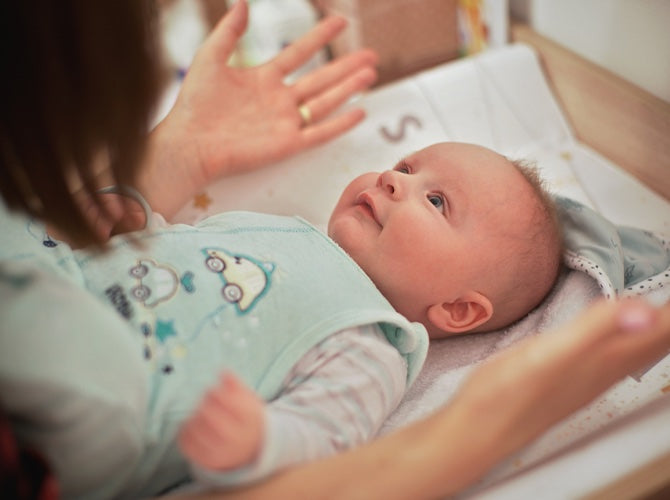 From their first night home from the hospital to the day they graduate to a big kid bed, you’ll want to do everything you can to ensure a safe, comfortable night’s sleep for your little one. A baby sleep sack can provide them with exactly what they need.
From their first night home from the hospital to the day they graduate to a big kid bed, you’ll want to do everything you can to ensure a safe, comfortable night’s sleep for your little one. A baby sleep sack can provide them with exactly what they need.But with so many choices on the market, it can all feel confusing. Don’t worry! In this article, we’ll share what you need to know to choose the best sleep sack for your baby.
Table Of Contents
- What is a baby sleep sack?
- What to look for in a baby sleep sack
- How to ensure a safe and comfortable night’s sleep
What is a baby sleep sack?

A baby sleep sack is a safe alternative to a blanket. It’s designed to keep your baby warm by enclosing their torso completely while leaving their arms free to move around.
Sleep sacks became popular in the United States in the 1990s during a major push to combat the rise of SIDS. There was a focus on what could be removed from the sleeping area that might interfere with a baby’s ability to breathe.
Now, safe sleep practices are more commonly known. The way you dress your baby for sleep is part of that.
How is a sleep sack different from a blanket?
Although both baby sleep sacks and blankets are used to keep babies warm, a loose blanket can pose a danger to a child.
For instance, if the blanket moves while your little one is sleeping, it might end up covering their face and impeding their ability to breathe, as a newborn baby does not yet have the strength to remove it or move away from the blanket.
As a result of this potential danger, the American Academy of Pediatrics recommends, “Keep loose blankets, pillows, stuffed toys, bumpers, and other soft items out of the sleep space.” In fact, the AAP asserts that blankets should not be used at all during the first year of life.
The prevailing line of thought is that less is more. So, if using a blanket is not recommended, then what can keep your little one warm at night? As we said, a sleep sack is the perfect answer.
With a properly fitted sleep sack, you can put your baby to bed without worry. These wearable blankets are fitted at the top so that they won’t ride up and cover your little one’s face.
Sleep sacks can be used from birth to two years old, or even longer if your child prefers them to pajamas, meaning you have a great solution for those precious first years. Sweet dreams, indeed!
How is a sleep sack different from a swaddle?

It’s important to note that a sleep sack is different from a swaddle and is often used after your baby outgrows the swaddling technique.
A swaddle is a thin blanket that you wrap your baby up in, kind of like a burrito. Because it’s wrapped so snugly, it’s thought to feel cozy like the womb and is soothing to your newborn, helping them sleep.
Swaddling is said to calm the Moro reflex, or the startle reflex, a response to new stimuli like loud noises or sudden movements. When the Moro reflex occurs, your baby will straighten their arms suddenly and might even gasp. Although this is completely normal, it can awaken them.
Swaddling restricts baby’s movements, keeping their arms safely tucked in the fabric of the swaddle. This is fine when they’re newborns but not when they get older.
In fact, swaddles are only safe until a baby begins to roll over, which is typically between three and four months. At this point, your little one needs their arms free.
Sleep sacks allow your baby’s arms to be out so they can push themselves back over or into a more comfortable and safe position.
What to look for an a baby sleep sack
There are several things to look for when you’re trying to choose the right baby sleep sack, including the fabric, sizing, and weight. Let’s take a look!
Natural, breathable fabrics
Before you choose the sleep sack that’s right for your little one, think about the materials that will come into contact with your baby’s skin. Cheap fabrics are often treated with harsh or even toxic chemicals that you would never want to expose your child to.
The main thing you want to think about is breathability. Babies are prone to overheating, and natural materials allow air circulation and the regulation of body temperature.
Here are a few of our favorite fabric choices.
Cotton
Cotton has become one of the most popular choices for baby clothing and sheets. It is breathable and soft against your little one’s skin, and you can be sure that they aren’t going to be exposed to any harmful chemicals.
Newborn skin is very fragile, and cotton fabrics should not be irritating. Be sure to look for products that are 100% cotton — ideally, 100% organic cotton.
Bamboo
Bamboo is extremely durable, luxuriously soft, and very moisture-absorbent. It also protects against UV rays and is hypoallergenic.
Bamboo is naturally stretchy, so it will easily take all those baby squirms in stride. Plus, it won’t irritate your baby’s delicate skin.
Sleep sacks made from bamboo may be slightly more expensive than those made from cotton, and you’ll have to be sure to wash them on the delicate cycle. They also might take longer to dry.
This being said, if you want a super-soft fabric for your baby, bamboo is a great choice.
Hemp
Hemp is similar to cotton in the way it feels against your skin. It’s not only soft, but it also becomes more and more comfortable the longer you wear it. Additionally, it can hold 20 times its weight in water and still feel dry to your skin.
Other big benefits are that hemp is UV resistant and provides natural protection from the sun, the fabric actively fights against bacteria and fungus, and it helps regulate your baby’s body temperature.
Merino wool
100% pure Merino wool is woven from very fine fibers to create a soft, breathable fabric.
Merino wool is safe for all skin types, even eczema-prone skin. Research shows that “fine-diameter Merino wool clothing” worn next to the skin “seems to be therapeutic to patients with mild to moderate atopic dermatitis.”
It also has temperature-regulating qualities that make it as useful in summer as it is in winter. In addition, it can help wick away moisture from the skin. Wool is also a natural flame retardant, making it a good material for sleepwear.
Look for GOTS-certified wool when you can, as well as natural, plant-based dyes.
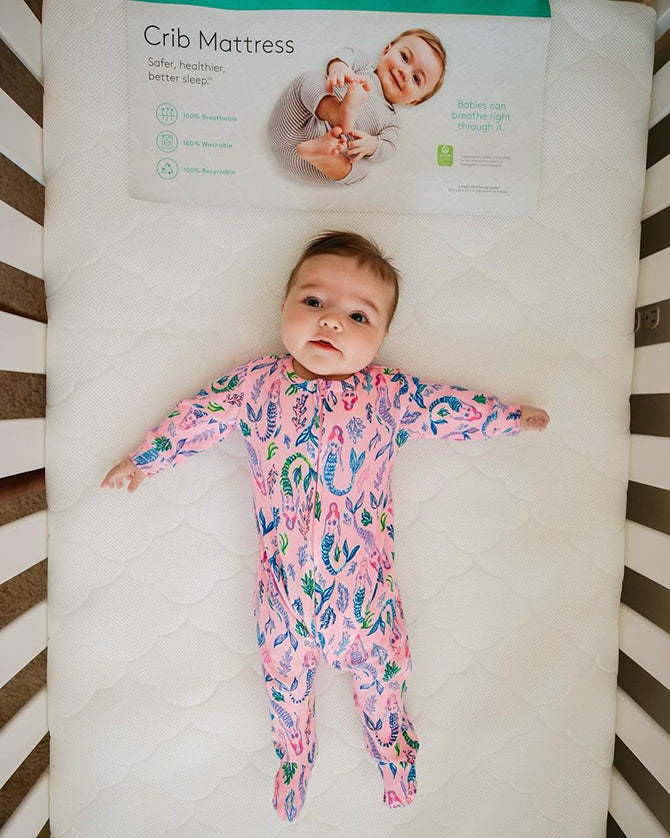
Breathable fabrics like cotton, bamboo, hemp, and Merino wool are great options for your baby’s sleep sack, and a Newton Baby breathable crib mattress is the perfect addition.
Not only is our Essential Crib Mattress breathable, but it’s also 100% washable. With a soft, eyelet removable cover and Wovenaire® core, our GREENGUARD Gold Certified mattresses help to ensure a good night’s sleep.

Sizing
In addition to the right material, be sure the baby sleep sack you choose is the right size for your little one.
It’s perfectly safe for a newborn to wear a sleep sack, but it should be made for an infant. You don’t want any possibility of your baby’s head or face being covered by material that is too large.
However, a baby sleep sack should be roomy throughout the bottom so little feet can kick and squirm. According to the Cleveland Clinic, a baby needs plenty of room for healthy hip development.
According to Dr. Emily Dodson of the Hospital for Special Surgery in New York, “We now know that tightly wrapping an infant’s legs could lead to hip dysplasia, so we recommend a newer, better way of swaddling. The safe way is to use a sleep sack that leaves lots of room for the legs…”
Sleeveless for safety
If your baby can roll over, they need to have their arms free to flip themselves back over in case they wind up on their stomach while sleeping and can’t breathe.
Babies start to roll over at about four months old. At first, they’ll rock themselves back and forth, and then they’ll flip all the way over. By six months, they should be able to flip over both ways with ease. A sleeveless sleep sack helps ensure nothing stands in the way of that.
Temperature control
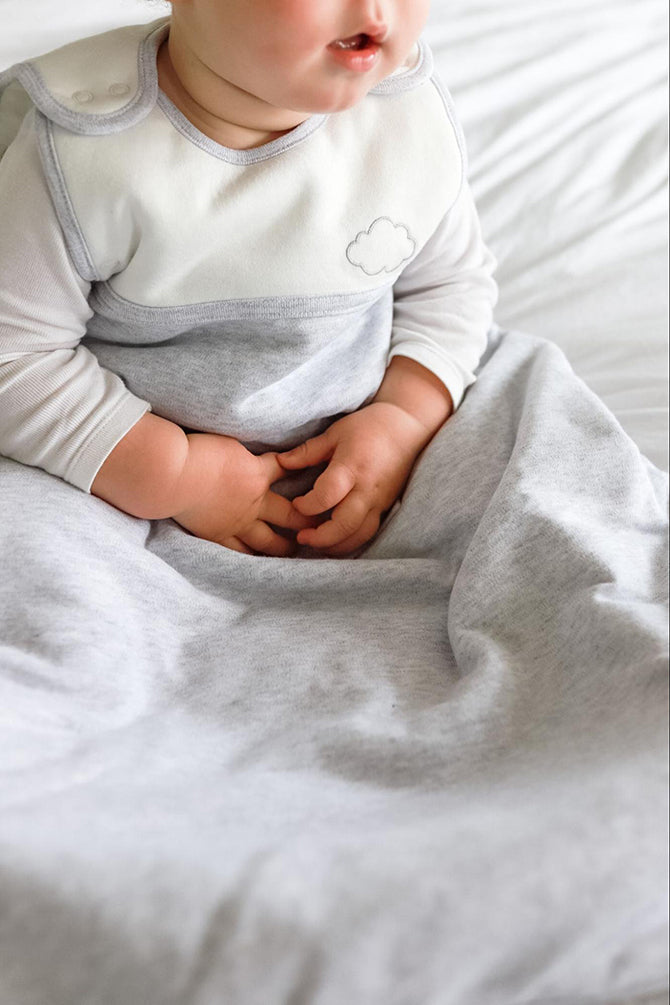
Baby sleep sacks can be used all year round. Just keep the material in mind for each season.
You may see the term “TOG” being used when it comes to baby sleep sacks or other clothing. TOG stands for Thermal Overall Grade and is used in the textile industry to measure thermal properties.
How do you know what the right material weight is for your baby at any time of year?
The higher the TOG rating number, the warmer the item. So a summer weight baby sleep sack TOG rating might be 0.5 — or the equivalent of two sheets. Winter weight baby sleep sacks, on the other hand, may have a TOG rating of 2.0 to 2.5.
In order to choose the right TOG for your sleep sack, you want to start with what your indoor temperature is. Just because it’s winter doesn’t mean you need a heavy sleep sack if it is warm inside.
The same thing goes for the summer. If the air conditioner is cooling the room, you’ll want to choose the best sleep sack with that in mind. Worried your baby is cold with their arms exposed? The best way to check your baby’s temperature is to touch their torso or neck.
If they are cold, add a layer of clothing or adjust the temperature in the room. Ideally, your baby’s room should be kept at approximately 68 to 72 degrees Fahrenheit.
The right type of closure
The right type of closure is an important factor in choosing the best baby sleep sack, especially because you’re likely to have to do middle-of-the-night (or nap) diaper changes. This means you need easy access to baby’s diaper area without waking them up.
Snaps can be fairly convenient, but it’s the snapping back up that may become irritating, especially at night when you’re sleepy.
You may find that you prefer zipper closures for your baby’s sleep sack rather than snaps. This is particularly true for older toddlers who may learn to unsnap at the shoulders and completely escape the sleep sack.
Zippers that go all the way to the bottom of the sleep sack allow the best access. You can zip out the lower half of your baby, change diapers, and zip them back in without exposing the baby’s chest to the coolness of the room.
Just be sure that the material is high quality and that you check the zipper regularly. A zipper pull can come free from the garment and be swallowed by your baby.
Closed At The Bottom
Baby sleep sacks are closed at the bottom as opposed to gowns, which are open at the bottom. This keeps little legs and feet warm. But the main advantage of a closed bottom is that the material will not ride up and cause any danger of suffocation.
On top of that, the closed bottom will prevent their little legs from getting stuck in-between the crib spindles.
No extra frills
Another thing you want to be sure of when choosing a baby sleep sack is that it’s as simple as possible. If it has extra ruffles or appliques, skip it. You don’t want anything that could potentially be a choking hazard if your baby gets it in their mouth.
How to ensure a safe and comfortable night’s sleep
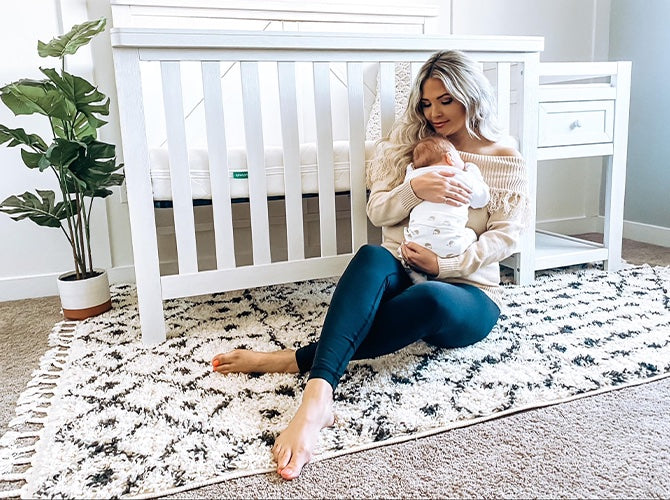
Safe sleep is vital for your little one. While it’s important to choose a sleep sack that has all the necessary requirements listed above, you’ll also want to make sure you properly prepare them for sleep and create and maintain a sleep routine.
As you do, of course, it’s also important to follow the American Academy of Pediatrics' safe sleep guidelines.
Create and maintain a sleep routine.
As you know, babies need plenty of sleep in order to grow. Both cognitive and physical development depend on it. Sleep also strengthens your baby’s memory and helps them manage their emotions.
A sleep routine can help ensure your little one is on a good path to development. There’s no one-size-fits-all routine, but yours might include a nice bubble bath, some relaxing music, a baby massage, and a good night story before nap and bedtime.
A sleep sack can be part of your baby’s bedtime routine as well. After the bath, change your little one into their sleep sack. They’ll relate this handy piece of clothing to going to bed. Then put them down on their breathable Newton crib mattress!
Here are some extra tips for your sleep routine:
- Make sure the room is comfortable and relaxing. Set the thermostat to 68 to 72 degrees, and turn on a white noise machine that will drown out any noises in the house.
- Keep the room dark. Light peeking into the windows can distract from good sleep.
- Maintain the same sleep schedule on weekdays and weekends.
- Be consistent with before-bed activities, like baths, books, and soft music. Your baby will be looking forward to it.
- Keep an eye on any changes in your little one’s sleep patterns. If their wake windows are getting longer, or if they’re getting fussy at bedtime, you might need to adjust.
- Be sure to change baby’s diaper before bed and give them an extra feeding before you nod off yourself. You might consider a dream feeding, where you feed your little one while they’re asleep.
- Always follow safe sleep practices. Guidelines are updated on occasion, so keep an eye out for the latest advice from the AAP (more on this below).
Follow safe sleep guidelines.
Here are some of the AAP’s safe sleep guidelines:
- Babies should be placed on their backs to sleep for the first year of life. Sleeping on their side or on their stomach is not safe (unless they roll themselves into that position).
- Use a firm sleep surface. Babies should be placed on a firm mattress in a safety-approved crib covered by a fitted sheet with no other bedding or soft objects.
- Avoid letting your baby sleep on a couch or armchair or in a seating device. This includes swings and infant car seats (unless your little one is riding in the car). If they do fall asleep in a chair, sofa, car seat, swing, or any other place not approved for infant sleep, move them to their bassinet, crib, or other sleep-safe space as soon as possible.
- Do not use products for sleep that are not specifically marketed for infant sleep.
- Babies should sleep on a separate sleeping surface but in the same room with their parents for at least the first six months. The AAP states that room-sharing can decrease the risk of SIDS by as much as 50%.
- Never use a weighted sleep product for babies, including swaddles, sleep sacks, sleepers, or blankets.
Don’t overdress them.
As sleep sacks are usually sleeveless, you’ll have to think about what baby wears underneath to make them most comfortable. In a temperate room, a single layer, like a footie or a onesie with socks, should be fine underneath to ensure a good night’s sleep.
You don’t want to bundle your little one up too much, as overheating is connected to an increased risk of SIDS. If it’s warmer in the room, be sure to use a lower TOG sleep sack. You can even just pair it with a diaper!
Know when to transition out of a sleep sack
Babies can use sleep sacks up until about two years old — or, more accurately, until they grow out of a two-year-old size. Most sleep sacks will accommodate infants up to about 30 pounds and 40 inches, although there are some that can be used for even older children.
This being said, because toddlers are active and don’t want the restriction of a sleep sack, most will switch to a blanket and regular pajamas at about the time they graduate to a toddler bed.
But if your child still likes the sleep sack, there’s no reason to transition them out of it. At this point, safety isn’t the issue — it’s really a matter of preference.
When you do transition to a blanket, introduce it for nap time first to get your little one used to the idea. They might be slow to adjust to a change in routine, or they might be excited about this milestone. Let them drive how quickly or slowly they transition.
Sleep sacks for peaceful nights
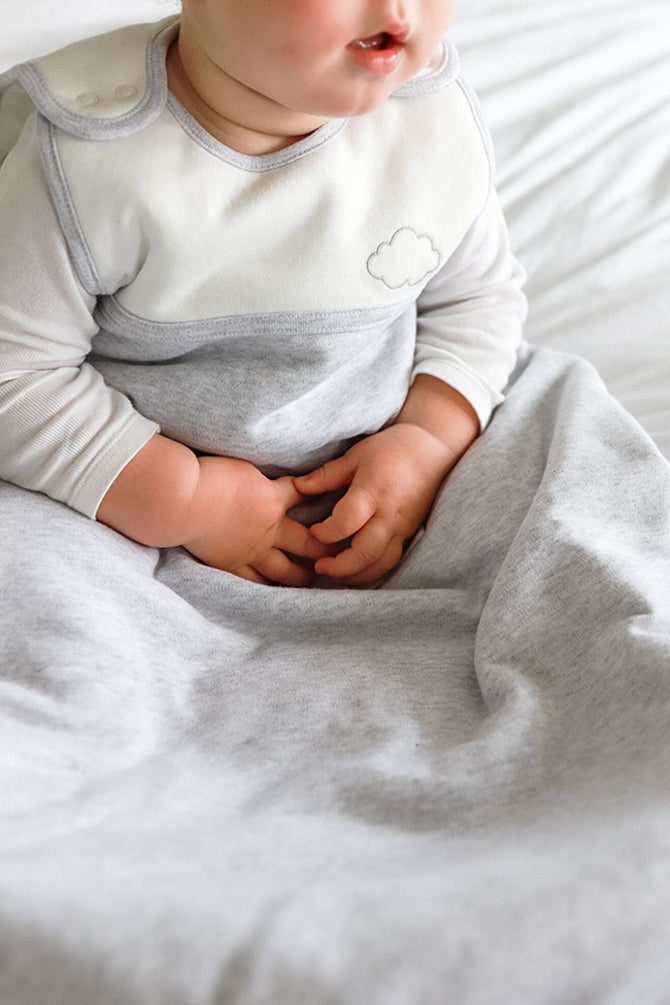
Baby sleep sacks are not only a warm and cozy way for your little one to sleep, but they can also keep them safe. In fact, the benefits of sleep sacks are backed by research, and doctors recommend using them.
By choosing a baby sleep sack in a natural, breathable fabric in the right weight and size, you’ll be well on your way to a safe, comfy sleep environment for your little one!
And since getting a good night’s sleep is just as important for your baby as it is for you, take a look at Newton Baby’s 100% breathable and washable Crib Mattresses. With all the tools you need in place, you and your baby will be snoozing safely and soundly every night!
